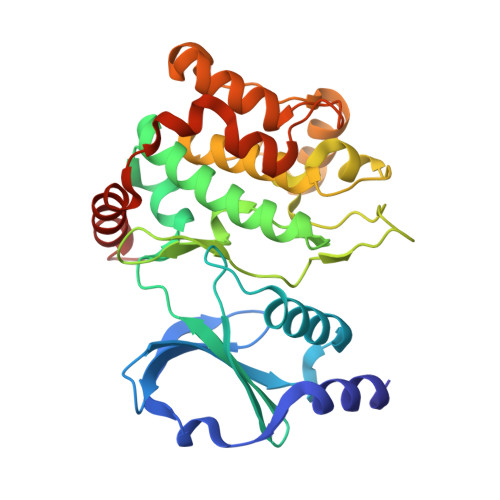Design of Selective PAK1 Inhibitor G-5555: Improving Properties by Employing an Unorthodox Low-pK a Polar Moiety.
Ndubaku, C.O., Crawford, J.J., Drobnick, J., Aliagas, I., Campbell, D., Dong, P., Dornan, L.M., Duron, S., Epler, J., Gazzard, L., Heise, C.E., Hoeflich, K.P., Jakubiak, D., La, H., Lee, W., Lin, B., Lyssikatos, J.P., Maksimoska, J., Marmorstein, R., Murray, L.J., O'Brien, T., Oh, A., Ramaswamy, S., Wang, W., Zhao, X., Zhong, Y., Blackwood, E., Rudolph, J.(2015) ACS Med Chem Lett 6: 1241-1246
- PubMed: 26713112
- DOI: https://doi.org/10.1021/acsmedchemlett.5b00398
- Primary Citation of Related Structures:
5DEY, 5DFP - PubMed Abstract:
Signaling pathways intersecting with the p21-activated kinases (PAKs) play important roles in tumorigenesis and cancer progression. By recognizing that the limitations of FRAX1036 (1) were chiefly associated with the highly basic amine it contained, we devised a mitigation strategy to address several issues such as hERG activity. The 5-amino-1,3-dioxanyl moiety was identified as an effective means of reducing pK a and logP simultaneously. When positioned properly within the scaffold, this group conferred several benefits including potency, pharmacokinetics, and selectivity. Mouse xenograft PK/PD studies were carried out using an advanced compound, G-5555 (12), derived from this approach. These studies concluded that dose-dependent pathway modulation was achievable and paves the way for further in vivo investigations of PAK1 function in cancer and other diseases.
Organizational Affiliation:
Genentech, Inc. , 1 DNA Way, South San Francisco, California 94080, United States.















